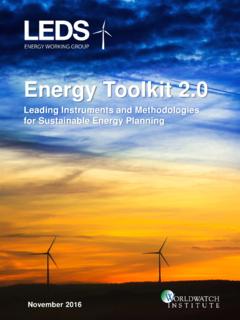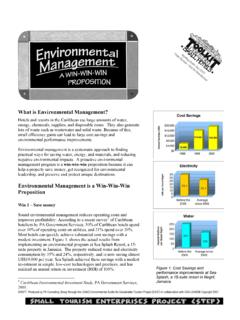Transcription of Caribbean Sustainable Energy Roadmap (C …
1 Katie Auth Mark Konold Evan Musolino Alexander Ochs Working Draft as of June 2013 Caribbean Sustainable Energy Roadmap (C-SERMS), Phase 1 Summary and Recommendations for Policymakers 1 Executive Summary The Caribbean region currently stands at a crossroads, faced with several critical challenges associated with the generation, distribution, and use of Energy . Despite tremendous renewable Energy resources, the region remains disproportionately dependent on imported fossil fuels, which exposes it to volatile and rising oil prices, limits economic development, degrades local natural resources, and fails to establish a precedent for global action to mitigate the long-term consequences of climate change, which pose a particularly acute threat to small-island states and low-lying coastal nations. The Caribbean Community (CARICOM) is poised to play a crucial role in the regional transition to Sustainable Energy .
2 CARICOM represents 15 diverse member states: Antigua and Barbuda, The Bahamas, Barbados, Belize, Dominica, Grenada, Guyana, Haiti, Jamaica, Montserrat, St. Kitts and Nevis, St. Lucia, St. Vincent and the Grenadines, Suriname, and Trinidad and Tobago. Although the geography, culture, and economic structures of these states vary widely, they face many common Energy challenges and opportunities. Recognizing the need to develop a coordinated regional approach to expedite the increased use of renewable Energy and Energy efficiency and chart a new, climate-compatible development path that harnesses indigenous renewable Energy resources, maximizes Energy use, minimizes environmental damage, and spurs economic growth and innovation, CARICOM adopted its regional Energy Policy in 2013 after a decade in development. To facilitate the process of translating intentions into action, the CARICOM Secretariat commissioned the first phase of the Caribbean Sustainable Energy Roadmap and Strategy (C-SERMS), designed to build on existing regional efforts and to provide CARICOM member states with a coherent strategy for transitioning to Sustainable Energy .
3 In this C-SERMS Phase 1 Summary and Recommendations for Policymakers report, the Worldwatch Institute provides an overview of the region s current Energy situation, recommends regional targets for renewable power capacity, Energy efficiency, and carbon emissions reductions in the short-term (2017), medium-term (2022), and long-term (2027), and outlines key strategies for achieving those goals. A more detailed baseline assessment can be found in the corresponding Baseline Assessment and Report prepared by Worldwatch. This report explores the options for Energy reform across a wide range of sectors, nearly all of which face significant Energy challenges: In the power sector, current generation relies heavily on dirty and expensive fuels, and is often insufficient to meet the needs of local populations. These challenges are often accentuated by isolated grid networks, high technical and non-technical losses, small overall generation capacity, outdated equipment, and a lack of financial resources to make needed advancements.
4 Transportation accounts for a significant share of total Energy consumption in nearly all member states, while Energy production, manufacturing, and extractive industries account for a majority of Energy consumption in certain member states. The tourism sector presents unique opportunities for rapid and significant impact because of its high Energy consumption and enormous economic importance regionally. Fortunately, extremely strong potential for utilizing domestic renewable resources exists across the region. Initial technical assessments indicate enormous opportunities for Sustainable Energy solutions 2 based on Energy efficiency improvements and the development of both baseload and variable renewable resources including geothermal, hydropower, modern biomass, solar, and wind. Current grid and storage infrastructure, however, is generally insufficient to support such developments on a large scale.
5 Although still relatively marginal in terms of their overall contribution to the region s Energy mix, renewable Energy technologies are already playing an increasingly significant role throughout CARICOM. Harnessing observed potential will require that a number of key technical assessment gaps be filled. Detailed Energy efficiency, renewable Energy , and grid and storage assessments are still lacking in many areas across the region and, in cases where these have been conducted, they are often not communicated or are not made publicly available. Despite the strong potential for Energy efficiency and renewable Energy observed in all CARICOM member states, the development of Sustainable Energy systems will not occur organically. The successful expansion of Sustainable Energy depends largely on the presence of a long-term vision, the effectiveness of existing policy and regulatory structures, and the surrounding governance and administrative framework.
6 To date, all 15 member states have adopted a national Energy policy or have a document in advanced stages of development. National policymakers across the region have set domestic targets to promote renewable Energy use. Many member states have already taken the lead in developing and implementing domestic policy mechanisms to support an increase in renewable Energy and Energy efficiency. At the regional level, policymakers have jointly established net-billing as the appropriate minimum standard for policy support across CARICOM. Despite these important initial steps, Sustainable Energy development across the region continues to be limited by policy and data gaps, administrative ineffectiveness, and often inefficient and uncoordinated implementation efforts. Regional collaboration among member states could transform the CARICOM Energy sector.
7 Based on an initial assessment of renewable resource potentials, existing Energy policy frameworks, and international best practices, Worldwatch has developed and recommended regional Sustainable Energy targets for renewable power capacity, Energy efficiency, and reductions in carbon dioxide (CO2) emissions in the short, medium, and long terms. In this report, Worldwatch recommends targets of 20 percent renewable power capacity by 2017, 28 percent by 2022, and 47 percent by 2027; a 33 percent reduction in Energy intensity by 2027; and power sector CO2 emission reductions of 18 percent by 2017, 32 percent by 2022, and 36 percent by 2027. These ambitious targets, many of which were adopted at the 41st Special Meeting of the Commission on Trade and Economic Development (COTED) on Energy , unite the region under a common vision and establish CARICOM as a global leader in renewable Energy promotion.
8 Through regional collaboration, CARICOM s 15 member states have a tremendous opportunity to maximize their individual resources and spearhead renewable Energy development by working together toward common and coherent goals. The CARICOM Energy Policy and the C-SERMS project are both critical steps toward a more cohesive approach to regional Energy planning. Many obstacles remain, however, that must be overcome through the promotion of priority projects, policies, and initiatives at the regional and national level. This study identifies and categorizes key initiatives that, if undertaken, will mitigate the unique information, finance, policy, and capacity barriers faced by the region and foster the development and deployment of renewable Energy and Energy efficiency across CARICOM. In addition to the full slate of high-impact activities, Worldwatch recommends three immediate next steps in translating regional commitments into sustained actions, facilitating CARICOM s Sustainable Energy transition.
9 3 Full transformation of the CARICOM Energy sector will be a long-term process requiring extensive commitment and dedicated collaboration among all member states and relevant regional and international actors. The regional approach outlined by C-SERMS will ensure that member states are supported by a network of actors and institutions united under a common vision. With continued commitment to transforming the regional Energy sector, CARICOM and its 15 member states can become global leaders in Sustainable Energy development. 4 Caribbean Sustainable Energy Roadmap and Strategy Phase 1 (C-SERMS-I) Summary and Recommendations for Policymakers Recognizing the need to develop a coordinated approach to addressing regional Energy challenges, the Caribbean Community (CARICOM) began developing its Energy Policy in 2002. Approved in 2013, the document promotes a shift to Sustainable Energy through increased use of renewable Energy sources and improvements in Energy efficiency.
10 In 2009, the Secretariat commissioned the Caribbean Sustainable Energy Roadmap and Strategy (C-SERMS), designed to build on existing regional efforts and to provide CARICOM member states with joint regional Sustainable Energy targets and a common, coherent strategy for transitioning to Sustainable Energy systems. The C-SERMS-I Baseline Report and Assessment provides an overview of the regional Energy situation, identifies critical information and data gaps, and recommends short- (2017), medium- (2022), and long-term (2027) targets for renewable Energy share, Energy efficiency improvements, and carbon dioxide emissions reductions in the power sector. This C-SERMS-I Summary and Recommendations for Policymakers summarizes the major findings of the Baseline Report and Assessment and recommends a strategic series of priority actions that CARICOM and its member states can undertake to achieve their goals.





